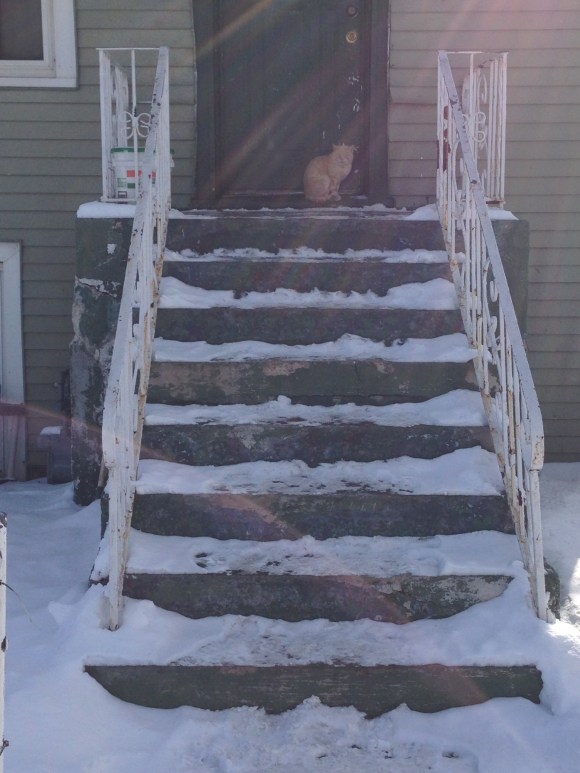Trap-Neuter-Return, TNR, for Outdoor Cats in Englewood
I met up with Chicago TNR again over the winter to help with trap-neuter-return, TNR, for outdoor cats in Englewood, a neighborhood in Chicago’s south side. My friend George started Chicago TNR by herself last year and has been humanely trapping colony cats all over the south side. She started trapping the Englewood cats last November in partnership with PAWS Chicago’s low-cost spay/neuter clinic.
By mid-December, in just six weeks, Chicago TNR Trapped-Neutered-Returned 93 cats in Englewood. 32 additional cats were Trapped-Neutered-Relocated to farms and warehouses that contacted PAWS Chicago looking to help pull cats off the streets and also for rodent control.
I joined George again one day in December in Englewood, where we trapped eight of those cats in less than two hours, just by driving around. George typically drives the PAWS’ van loaded with Tru-Catch traps, pet carriers, cat food for donations and bait, and other items needed for TNR projects, including newspapers, paper plates, and sheets to cover the traps.
 The cats are everywhere outside there, and we decided just to go to places where we knew there were community cats.
The cats are everywhere outside there, and we decided just to go to places where we knew there were community cats.
I met up with George at this TNR’d feral cat colony.

These cats are well fed and have shelter under the front porch.
 We moved on to an alley right around the corner where we saw a few cats, including this orange and white cat with a flea collar. We asked around but no one claimed him as theirs, so we decided to try to trap and take him to the clinic.
We moved on to an alley right around the corner where we saw a few cats, including this orange and white cat with a flea collar. We asked around but no one claimed him as theirs, so we decided to try to trap and take him to the clinic.

He was suspicious but clearly hungry. So we set up a trap.

And got him a few minutes later.

We quickly moved on to another block where George knew of a colony and visited the feeder’s house. A well-endowed male cat was hanging out on her front steps.

After a quick consultation with the feeder, who claimed him as one of her indoor/outdoor pet cats, we got him into a carrier to be neutered as well.

Around the corner from there we placed a Rubbermaid bin cat house for shelter.

It is well concealed from the street and you would hardly notice it, but hopefully it will help keep a few cats warm in the winter.

From there we moved even more quickly. The feeder told us about a few cats down the street, and we saw them right away. We placed two traps baited with tuna near another feeder’s front steps, and two cats obliged by going in them immediately. These cats were hungry.

The woman that was feeding them was moving out of the neighborhood that day and was very grateful for our help. She told us that there were other feeders on that block so these cats are cared for.
George and I decided to split up at that point and she drove to another spot while I continued TNR on this block.
A few doors down this long-haired beauty came running down the steps and out of the gate to greet me on the sidewalk.

I talked to her feeder as well, who said she was friendly, but they could not let her permanently into their home. She followed me down the block once she smelled the food.

She was easy to gently push into a trap.

George came back at this point fairly quickly with two more cats in traps, and another pet cat in a carrier. So now we had eight cats. It was freezing outside and we decided to wrap it up.
She wanted to show me Sabrina’s Colony. This is a colony of over a dozen cats. Sabrina feeds diligently, and rescues friendly cats and kittens all the time on her own.
The cats are gorgeous and well fed. They all came running when they saw us.

This tabby cat appeared to be the ringleader.

We were out of paper plates, but we fed them anyways on the ground.
These cats have ample shelters on her front porch.

From there we took all of the cats to PAWS Chicago’s low cost spay/neuter clinic. We met up with a few other feral cat trappers who were also dropping off their cats. We made sure each cat in a trap was fed. Every trap was lined with clean newspaper for the cats to sit on, and each trap was covered with a sheet so that the feral cats would be calmed in the traps. Here they are ready for their spay/neuter surgeries, vaccinations, parasite treatments, and ear tipping.

Once the cats are fully recovered from their surgeries, usually within 24 to 48 hours, George then returns the cats to where they were trapped. In this case, the pet cats were returned to their owners, and three of the cats in traps, including the long-haired beauty that ran to greet me, were relocated into companies requesting cats for rodent control in their warehouses, while also feeding and caring for them and providing shelter.
I look forward to helping George in this neighborhood again. There are too many intact cats running outside here and the residents welcome any help they can get.